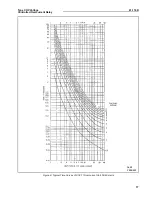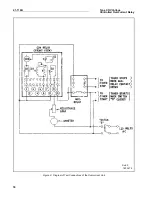
41-116K
7
Type COV Voltage
Controlled Overcurrent Relay
6.1.4. Voltage Unit (V)
A. Contact Gap
The gap between the stationary contact and
moving contact with the relay in a de-energized
position should be approximately .020”.
B. Sensitivity
The contacts should close when voltage is
reduced to approximately 90 volts. The voltage
unit should be energized for one hour before
checking the sensitivity.
6.2
ROUTINE MAINTENANCE
All relays should be inspected periodically and the
time of operation should be checked at least once
every year or at such other time intervals as may be
dictated by experience to be suitable to the particular
application. Phantom loads should not be used in
testing induction-type relays because of the resulting
distorted current wave form which produces an error
in timing.
All contacts should be periodically cleaned. A contact
burnisher Style 182A836H01 is recommended for
this purpose. The use of abrasive material for clean-
ing contacts is not recommended, because of the
danger of embedding small particles in the face of
the soft silver and thus impairing the contact.
6.3
CALIBRATION
Use the following procedure for calibrating the relay if
the relay has been taken apart for repairs or the
adjustments have been disturbed. This procedure
should not be used unless it is apparent that the relay
is not in proper working order. (See “Acceptance
Check”).
6.3.1. Overcurrent Unit (CO)
A. Contact
1) By turning the time dial, move the moving
contacts until they deflect the stationary contact
to a position where the stationary contact is rest-
ing against its backstop. The index mark located
on the movement frame should coincide with the
“O” mark on the time dial. For double trip relays,
the follow on the stationary contacts should be
approximately 1/64”.
2) For relays identified with a “T”, located at
lower left of stationary contact block, the index
mark on the movement frame will coincide with
the “O” mark on the time dial when the stationary
contact has moved through approximately one-
half of its normal deflection. Therefore, with the
stationary contact resting against the backstop,
the index mark is offset to the right of the “O”
mark by approximately .020”. The placement of
the various time dial positions in line with the
index mark will give operating times as shown on
the respective time-current curves. For double
trip relays, the follow on the stationary contacts
should be approximately 1/32”.
B. Minimum Trip Current
The adjustment of the spring tension in setting
the minimum trip current value of the relay is
most conveniently made with the damping mag-
net removed.
With the time dial set on “O”, wind up the spiral
spring by means of the spring adjuster until approxi-
mately 6-3/4 convolutions show.
Set the relay on the minimum tap setting, the time
dial to position 6.
Adjust the control spring tension so that the moving
contact will leave the backstop at tap value current
+1.0% and will return to the backstop at tap value
current -1.0%.
C. Time Curve Calibration
Install the permanent magnet
Apply the indicated current per Table 1 for the perma-
nent magnet adjustment (e.g., COV-8, 2 times tap
value) and measure the operating time. Adjust the
permanent magnet keeper until the operating time
corresponds to the value of Table 1.
For type COV-11 relay only, the 1.30 times tap
value operating time from the number 6 time dial
position is 54.9
±
5% seconds. It is important that the
1.30 times tap value current be maintained accu-
rately. The maintaining of this current accurately is
necessary because of the steepness of the slope of
the time-current characteristic (Figure 7, page 16). A
1% variation in the 1.30 times tap value current
(including measuring instrument deviation) will
change the nominal operating time by approximately
4%. If the operating time at 1.3 times tap value is not
within these limits, a minor adjustment of the control
spring will give the correct operating time without any
undue effect on the minimum pick-up of the relay.
This check is to be made after the 2 times tap value
adjustment has been completed.








































